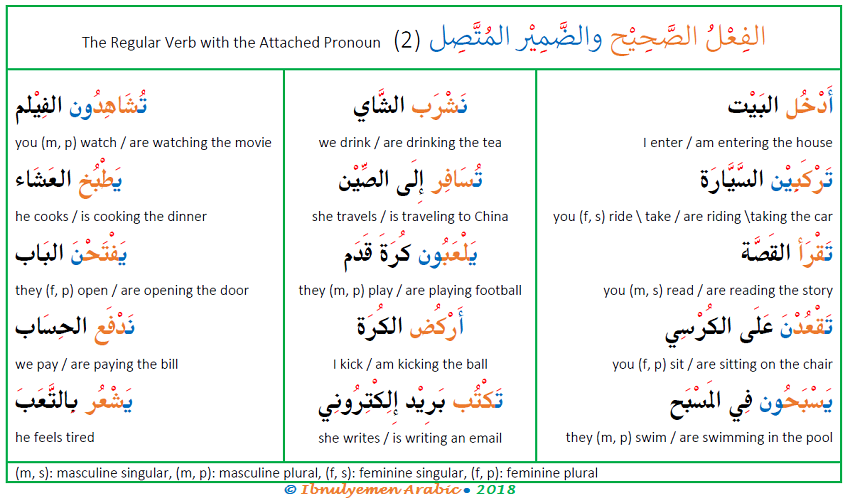 At the start of the imperfective verb الفِعْل المُضارِع, there are four single-letter prefixes: أَ ، نَـ ، يـَ ، تَـ. For now, let’s say that they indicate that the verb (i.e. the action) is / takes place in the present. Unlike the perfective form, not every personal pronoun shows as an attached pronoun at the end of the imperfective verb. That is, half of the them are covert مُسْتَتِر.
Since repetition speeds up learning and helps with vocabulary retention, let’s change verbs in last lessons into the imperfective form.
At the start of the imperfective verb الفِعْل المُضارِع, there are four single-letter prefixes: أَ ، نَـ ، يـَ ، تَـ. For now, let’s say that they indicate that the verb (i.e. the action) is / takes place in the present. Unlike the perfective form, not every personal pronoun shows as an attached pronoun at the end of the imperfective verb. That is, half of the them are covert مُسْتَتِر.
Since repetition speeds up learning and helps with vocabulary retention, let’s change verbs in last lessons into the imperfective form.
| Separate | Attached | Imperfective Form Examples | Explanation |
| أنَا | أَ .. | أَكْتُب رِسَالَةً – I am writing a letter
أَشْرَب كُوبًا مِنَ الشَّاي – I am drinking a cup of tea أرْقُد عَلَى الكَنَبَة – I am sleeping on the sofa |
أَ indicates the 1st person singular, نـ indicates the 1st person plural. The subject of both verbs is covert مُسْتَتِر that can be deduced from أ and نـ as أَنَا and نَحْنُ, respectively. |
| نَحْنُ | نـ .. | نَـذْهَب إِلَى السُّوْق – we are going to the market
نُـشَاهِد التِّلْفَاز – we are watching the TV نُـنَظِّف البَيْت – we are cleaning the house |
|
| أَنْتَ | تـ .. | تَــقْرَأ رُوَايَة جَدِيْدَة – you are reading a new novel
تَـضْحَك مَعَهُم – you are laughing with them تَــفْتَح البَاب – you are opening the door |
تـ at start of the verbs indicates the 2nd person, so it occurs with all verb forms. The verb form with أَنْتَ is the default form (i.e. the form from which all others are derived), so its subject is covert understood from يـ as أَنْتَ. The ـين is the attached subject pronoun for أَنْتِ. The ـون is the attached subject pronoun for أَنْتُم. And the ـن is the attached subject pronoun for أَنْتُنَّ. |
| أَنْتِ | تـ .. ـين | تَـخْرُجِـيْن مِنَ البَيْت – you are going out
تَـطْبُخِــيْن بَامِيَة – you are cooking okra تَــغْـسِلِــيْن مَلابِسَكِ – you are washing your clothes |
|
| أَنْتُم | تـ .. ـون | تَـلْعَبُـون فِي الحَدِيْقة – you are playing in the garden
تَــقْـفِزُون إِلَى النَّهر – you are jumping to the river تَـسْبَحُـون فِي النَّهْر – you are swimming in the river |
|
| أَنْتُنَّ | تـ .. ـنَ | تَـنْزُلْـنَ مِنَ السَّيَّارَة – you are getting off the car
تَـفْتَحْـنَ بَابَ السَّيَّارَة – you are opening the car door تَــعْرِفْـنَ الإِجَابَة – you know the answer |
|
| هُوَ | يـ .. | يَـدْرُس التَّارِيْخ – he is studying history
يَـأخُذ الكِـتَاب – he is taking book يَـحْمِل الشَّنْطَة – he is carrying the bag |
يـ at the beginning of the verbs signifies the 3rd person, so it occurs with all verb forms. With هِيَ, the feminine marker تـ replaces the يـ. With both هُوَ and هِيَ, the subject is covert implied by the يـ and تـ as هُوَ and هِيَ, respectively. The ـون is the attached subject pronoun for هُم. And the ـنَ is the attached subject pronoun for هُنَّ. |
| هِيَ | تـ .. | تَـجْلِس عَلَى المَقْعَد – she is sitting on the bench
تَـذْهَب إِلَى الجَامِعَة – she is going to the university تَـدْخُل إِلَى الغُرْفَة – she is coming in to the room |
|
| هُم | يـ .. ـون | يَـرْفُضُـون الفِكْرَة – they are rejecting the idea
يَــعْطُسُـون – they are sneezing يَـرْجَعُـون إِلَى البَيْت – they are returning home |
|
| هُنَّ | يـ .. ـنَ | يَـلْبَسْـنَ مَلابِس جِدِيْدة – they are wearing new clothes
يُـسَافِرْنَ إِلَى القَرِيَة – they are travelling to the village يَـطْبُخْـنَ العَشَاء – they are cooking dinner |
|
| Note: Besides signifying the present tense, أ, نـ, تـ, and يـ stand for persons. That is, أ is for the 1st person singular; نـ is for the 1st person plural; تـ is for the 2nd person (all forms); and يـ is for the 3rd person (again, all forms). The تـ with هِي replaces the يـ to distinguish between the 3rd person masculine singular and the 3rd person feminine singular. | |||